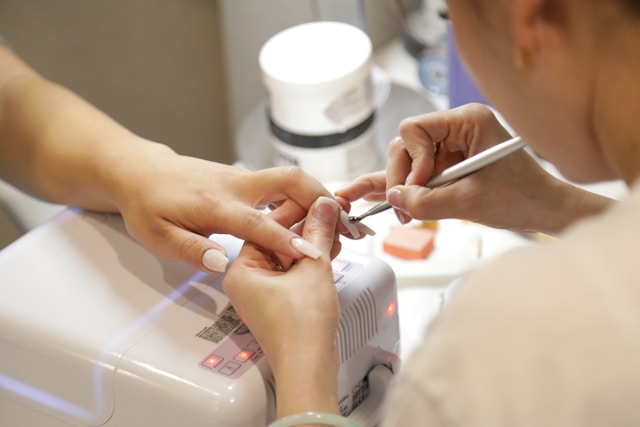
The pungent aroma of nail varnish and disinfectant hangs in the air, gentle sounds of relaxing music flow through the room, and expert hands magically create artistic designs on fingernails – detailed floral patterns, glitter, or simply a single-coloured manicure. Nail bars are places of beauty and self-care, and for many, oases of relaxation. But those glittering façades often conceal darker realities – because working conditions there are anything but as glamorous as the image projected.
WHEN CAN WE DESCRIBE A SITUATION AS “EXPLOITATION OF LABOUR”?
When people hear the word “exploitation”, they often think of the sexual exploitation of women and children. It’s important to remember, however, that exploitation can take many forms, and is far from limited to this scenario alone. According to § 104a, Clause 3 of the Austrian Criminal Code, exploitation can be understood as sexual exploitation, exploitation by removal of organs, exploitation of labour, exploitation for the purpose of begging, or exploitation for the purpose of committing criminal acts.
Under Austrian law, a worker’s employment is considered exploitative if the victim is either not paid at all, or is only paid an insufficient wage, for the work or service he or she provides for an extended period of time. The labour can also be described as exploitative if the permitted or reasonable working hours subject to legal requirements are extended excessively for a longer period, or the victim is forced to perform the required service subject to unreasonable working conditions. Where a person is employed in Austria, only Austrian legal standards, or those subject to the collective agreement, are decisive. Whether or not the people affected have agreed to the working conditions or perceive these as exploitation does not play a role here; in other words, the victim themselves need not feel exploited for the labour to be described as exploitative. In Austria, cases of labour exploitation are particularly well-known in households, care services, gastronomy, the construction sector, agriculture and sex work. But this labour exploitation – as often assumed – doesn’t take place behind closed doors; rather, it extends to apparently innocent spaces such as nail bars.
CHEAP GEL NAILS, EXPLOITED STAFF
It is hardly surprising that nail bars offering low prices have been popping up everywhere in recent years: the manicures which were once the preserve of women in elite society have been available to all for some time now. Increasing numbers of people, including businessmen, young people, and young mothers wishing to treat themselves to some “out time”, are queuing up to visit the bars offering these beauty services. Both in cities and out in the countryside, the bars can now be found on every street corner.
This boom is not necessarily good news for those employed at the bars, however: cheap nail bars have been presented negatively in the foreign press in recent years, particularly in countries such as Great Britain, Germany and Switzerland. They are reported to be in the clutches of networks which systematically bring people from countries in Asia, primarily Vietnam, to Europe, to exploit their labour. In Austria , too, individual cases have been reported in the past.
In 2022, the Advocacy and Support for Migrant Women and Victims of Human Trafficking (Women’s Information Centre) Zurich specialist unit published a survey which focussed on the exploitation of those affected by human trafficking in Switzerland, particularly in the context of nail bars, and the associated labour exploitation.
LOW WAGES, LACK OF REGULATIONS, LONG WORKING HOURS
Research carried out by the Advocacy and Support for Migrant Women and Victims of Trafficking (Women’s Information Centre) specialist unit Zurich shows that potential victims are under pressure. The victims are usually people from Vietnam and neighbouring countries who, due to poverty, climate change and destruction of their livelihoods, are forced to seek possible means of surviving elsewhere. Migration to Europe is costly, however, and, due to the restrictive migration policy of Switzerland, doesn’t always take place legally. This means the migrants are vulnerable to exploitation by human traffickers, who offer expensive services such as the organisation of residence documents and work permits. The debts incurred as a result put those affected under pressure, and mean they are open to blackmail, creating increased vulnerability.
The nail industry presents another problem insofar as it is barely regulated, has no minimum wage, no collective bargain agreement and low entry requirements, either for employees or employers. As a result, working conditions in the sector are particularly unfavourable, and low wages, long working hours and a lack of health protection (use of chemicals, exposure to fine particulates) are frequent. Identifying the victims of labour exploitation can be challenging, however. Few victims are prepared to make statements, and some don’t even feel they are being exploited, since despite their concerns, they are still earning more than they do in their country of origin. The Women’s Information Centre specialist unit reports that the people affected are often plagued by fears of deportation, violence or threats against their family in their country of origin. It is even more difficult to prove that the perpetrators are guilty of human trafficking. As a result of these factors, the actual figure for cases is probably far higher.
FIGHTING EXPLOITATION?
In conclusion, therefore, exploitation in nail bars represents an urgent problem. The Advocacy and Support for Migrant Women and Victims of Trafficking (Women’s Information Centre) specialist unit in Zurich recommends a range of measures to counter exploitation at nail bars:
- In the nail industry itself, we should be striving to achieve improved worker protection, including support for (self-)organisation through trade unions.
- During official checks, the focus should be on working conditions and exploitation, to prevent criminalisation of potential victims. Identification of those affected by human trafficking for labour exploitation should be improved, and collaboration with victim protection organisations strengthened at an early date. Law enforcement and labour market authorities should be trained in the special nature of human trafficking for labour exploitation.
- In victim protection, it is recommended that victims’ rights be strengthened in the criminal code.
- In relation to migration laws, it is suggested that legal labour and migration routes be created to reduce dependencies, openness to blackmail, and vulnerability.
- Specialist units require more sensitisation, networking and media work.
Translated by Tim Lywood
#Menschenhandel #Ausbeutung #Arbeitsausbeutung #ModerneSklaverei #ModerneSklaven #Nagelstudio #Nagelbranche AgainstHumanTrafficking #GegenMenschenhandel #EndExploitation #EndTrafficking #HopeForTheFuture #Österreich
